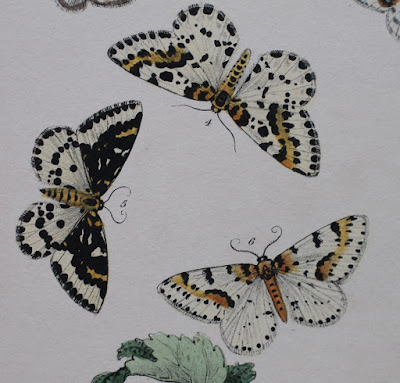15 August 2017
15 August 2017 – Magical Circle of Moths
 |
| Magpie moth (Abraxas grossulariata) in variety |
A strange similarity to the last blog. Three moths of the same species beautifully illustrated by Henry Noel Humphreys once again, but this time they are Magpie moths and their circle might be easily conceived as magical. Abraxas is a Coptic word coined by the Gnostic teacher Basilides. He wished the word to represent the number 365 – the number of days in the year. Gem stones were inscribed with the magical word together with images of entwined human and animal forms. The word Abracadabra, the conjuror’s word is from the same root. The arrangement in the image seems appropriate.
The three moths show examples of the variations of pattern on the wings of the Magpie moth – the photograph below is the one that was lured by the mercury vapour lamp.
 |
| Magpie Moth (Abraxas grossulariata) |
The second half of the binomial refers to the thorny plant beneath – the gooseberry. This little plant is growing close to a stone wall and is, I think, the only example in the garden. There is no sign of caterpillar activity on the leaves so this moth must have flown in from a neighbouring garden.
 |
| Gooseberry |
Not the best of images but I was lucky to get one at all as this moth rushes back and forth in a very animated state. The Honeysuckle Moth (Ypsolopha dentella) with the tooth-like shape to the wings when at rest. Ypsolopha means ‘high crested’ and the food plant is honeysuckle.
 |
| Honeysuckle Moth (Ypsolopha dentella) |
 |
| Honeysuckle Moth illustration |
The little hooks on the end of the fore-wings (seen in the illustration), form the ‘dentella’ that can be seen in the photograph of the moth on a rose stem. Rather wonderful in its own way.
Recent Moths
- 25 July 2023 – Collective Noun for Hawkmoths
- MOTH LIST to August 2023 with links
- 28 July 2023 – TRIPLE New Species Alert!
- 18 July 2023 – A Golden…Plusia!
- 13 July 2023 – Arts and Sciences
- 10 July 2023 – Rise of the Yellow Underwings
- 4 July 2023 – Cold-weather Catch
- 4 July 2023 – Mother of Pearl, an Inspiration to Science
- 28 June 2023 – Buff-tipped Marble
- 23 June 2023 – Moth or Butterfly?
- 20 June 2023 – Bee, Straw, Emerald and a Ghost
- 17 June 2023 – Old and New






